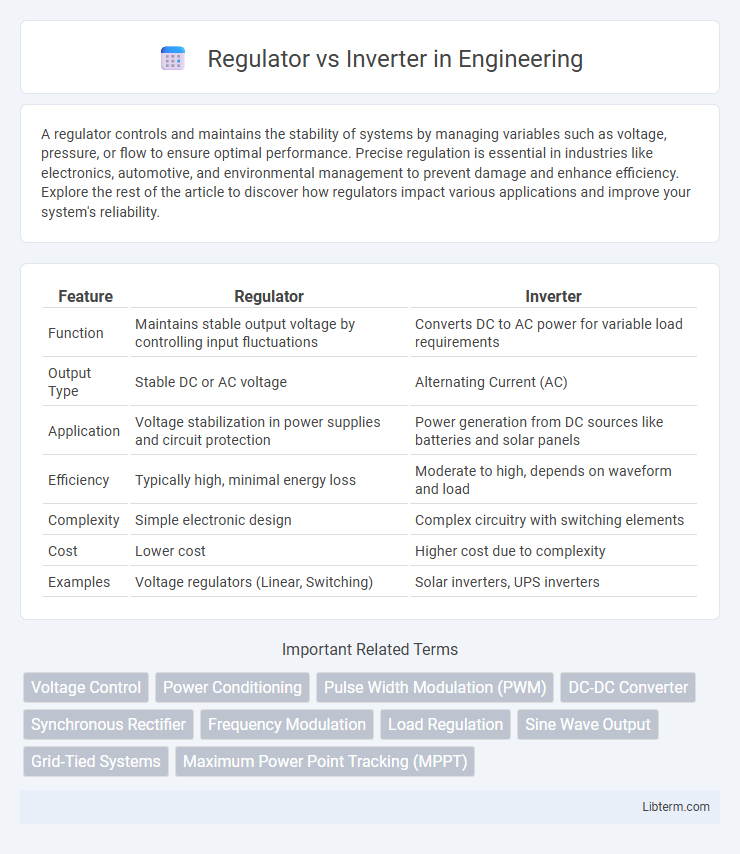A regulator controls and maintains the stability of systems by managing variables such as voltage, pressure, or flow to ensure optimal performance. Precise regulation is essential in industries like electronics, automotive, and environmental management to prevent damage and enhance efficiency. Explore the rest of the article to discover how regulators impact various applications and improve your system's reliability.
Table of Comparison
| Feature | Regulator | Inverter |
|---|---|---|
| Function | Maintains stable output voltage by controlling input fluctuations | Converts DC to AC power for variable load requirements |
| Output Type | Stable DC or AC voltage | Alternating Current (AC) |
| Application | Voltage stabilization in power supplies and circuit protection | Power generation from DC sources like batteries and solar panels |
| Efficiency | Typically high, minimal energy loss | Moderate to high, depends on waveform and load |
| Complexity | Simple electronic design | Complex circuitry with switching elements |
| Cost | Lower cost | Higher cost due to complexity |
| Examples | Voltage regulators (Linear, Switching) | Solar inverters, UPS inverters |
Understanding Regulators and Inverters
Regulators maintain a constant voltage output by adjusting fluctuations in input voltage to protect electronic devices from damage or performance issues. Inverters convert direct current (DC) from sources like batteries or solar panels into alternating current (AC) used by household appliances and industrial equipment. Understanding the specific roles of voltage regulators and inverters is crucial for designing efficient power systems and ensuring device compatibility and energy stability.
Core Functions: Regulator vs Inverter
Regulators maintain a constant voltage output by stabilizing fluctuations from the power source, ensuring consistent electrical performance. Inverters convert direct current (DC) into alternating current (AC), enabling the use of DC power for AC appliances and grid compatibility. While regulators focus on voltage stability, inverters prioritize power conversion for functional adaptation across different electrical systems.
Key Components and Working Principles
Regulators typically include components such as Zener diodes, transistors, and resistors to maintain a constant output voltage by adjusting current flow based on input variations. Inverters consist of components like transistors, transformers, and capacitors to convert direct current (DC) into alternating current (AC) through switching and frequency modulation techniques. The working principle of regulators involves voltage stabilization by dissipating excess energy, while inverters operate by generating alternating voltage waveforms from a DC source using electronic switching devices.
Applications in Power Management
Regulators provide steady voltage output crucial for sensitive electronic devices, ensuring consistent power supply in applications like microprocessors, communication equipment, and battery-powered gadgets. Inverters convert DC to AC power, essential in solar power systems, uninterruptible power supplies (UPS), and electric vehicle drive trains to enable compatibility with AC-powered devices and grid integration. Both components optimize power management by enhancing efficiency, stability, and adaptability in various energy systems.
Advantages of Using Regulators
Regulators provide stable voltage output, ensuring sensitive electronic devices operate safely without fluctuations that can cause damage or reduce lifespan. They improve energy efficiency by minimizing power loss and optimizing voltage delivery, which is essential for maintaining consistent performance. Their reliability and ease of integration make regulators ideal for applications requiring precise voltage control, such as in telecommunications and industrial automation systems.
Benefits of Inverters in Modern Systems
Inverter technology significantly enhances modern electrical systems by providing efficient energy conversion from DC to AC, enabling seamless integration with renewable energy sources such as solar panels. Unlike traditional regulators, inverters offer superior voltage stabilization, minimize power loss, and support variable frequency output, which optimizes the performance of connected devices. These benefits lead to reduced energy costs, improved system reliability, and increased compatibility with smart grid infrastructure in residential and industrial applications.
Efficiency Comparison: Regulator vs Inverter
In terms of efficiency, inverters typically outperform voltage regulators by converting DC to AC power with efficiency rates often exceeding 90%, while traditional linear voltage regulators usually operate at 50-70% efficiency due to power dissipation as heat. Switching regulators achieve higher efficiency, comparable to inverters, by rapidly switching on and off to maintain voltage levels with minimal loss. The choice between regulator and inverter depends on the application requirements, with inverters favored for AC power needs and regulators preferred for stable DC voltage output.
Cost Implications and Maintenance Needs
Regulators typically incur lower upfront costs but may require frequent maintenance due to mechanical wear and limited efficiency. Inverters, while having higher initial expenses, offer improved energy conversion efficiency and reduced maintenance needs through solid-state components. Long-term cost implications favor inverters for applications demanding durability and energy savings.
Choosing the Right Device for Your Requirements
Choosing the right device between a regulator and an inverter depends on your specific power needs and application. Regulators efficiently stabilize voltage to protect sensitive electronics by maintaining consistent output despite input fluctuations, making them ideal for devices requiring steady DC power. Inverters convert DC to AC power, essential for running household appliances or equipment from battery sources, and selecting one with appropriate wattage and waveform is crucial for optimal performance and longevity.
Future Trends in Power Regulation and Inversion
Future trends in power regulation and inversion emphasize the integration of smart grid technologies and advanced semiconductor materials like silicon carbide (SiC) and gallium nitride (GaN) to enhance efficiency and durability in regulators and inverters. The shift towards decentralized energy systems drives innovation in adaptive power converters capable of real-time load balancing and predictive maintenance using AI algorithms. Increased adoption of renewable energy sources further accelerates the development of bi-directional inverters and dynamic voltage regulators tailored for fluctuating power inputs and varying grid demands.
Regulator Infographic

 libterm.com
libterm.com